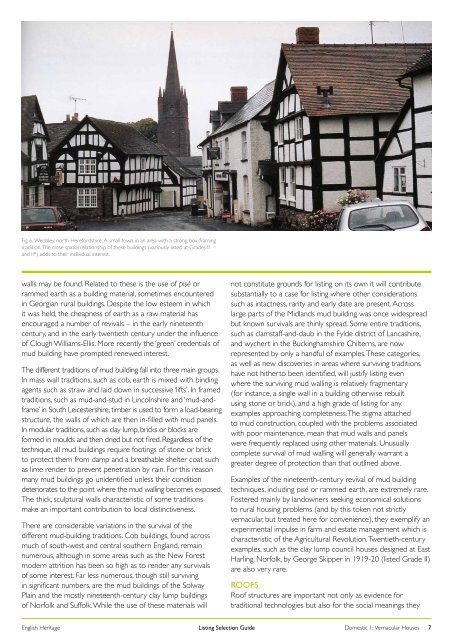Domestic 1: Vernacular Houses - English Heritage
Domestic 1: Vernacular Houses - English Heritage
Domestic 1: Vernacular Houses - English Heritage
You also want an ePaper? Increase the reach of your titles
YUMPU automatically turns print PDFs into web optimized ePapers that Google loves.
Fig 6. Weobley, north Herefordshire. A small town in an area with a strong box-framing<br />
tradition. The close spatial relationship of these buildings (variously listed at Grades II<br />
and II*) adds to their individual interest.<br />
walls may be found. Related to these is the use of pisé or<br />
rammed earth as a building material, sometimes encountered<br />
in Georgian rural buildings. Despite the low esteem in which<br />
it was held, the cheapness of earth as a raw material has<br />
encouraged a number of revivals – in the early nineteenth<br />
century, and in the early twentieth century under the influence<br />
of Clough Williams-Ellis. More recently the ‘green’ credentials of<br />
mud building have prompted renewed interest.<br />
The different traditions of mud building fall into three main groups.<br />
In mass wall traditions, such as cob, earth is mixed with binding<br />
agents such as straw and laid down in successive ‘lifts’. In framed<br />
traditions, such as mud-and-stud in Lincolnshire and ‘mud-andframe’<br />
in South Leicestershire, timber is used to form a load-bearing<br />
structure, the walls of which are then in-filled with mud panels.<br />
In modular traditions, such as clay lump, bricks or blocks are<br />
formed in moulds and then dried but not fired. Regardless of the<br />
technique, all mud buildings require footings of stone or brick<br />
to protect them from damp and a breathable shelter coat such<br />
as lime render to prevent penetration by rain. For this reason<br />
many mud buildings go unidentified unless their condition<br />
deteriorates to the point where the mud walling becomes exposed.<br />
The thick, sculptural walls characteristic of some traditions<br />
make an important contribution to local distinctiveness.<br />
There are considerable variations in the survival of the<br />
different mud-building traditions. Cob buildings, found across<br />
much of south-west and central southern England, remain<br />
numerous, although in some areas such as the New Forest<br />
modern attrition has been so high as to render any survivals<br />
of some interest. Far less numerous, though still surviving<br />
in significant numbers, are the mud buildings of the Solway<br />
Plain and the mostly nineteenth-century clay lump buildings<br />
of Norfolk and Suffolk. While the use of these materials will<br />
not constitute grounds for listing on its own it will contribute<br />
substantially to a case for listing where other considerations<br />
such as intactness, rarity and early date are present. Across<br />
large parts of the Midlands mud building was once widespread<br />
but known survivals are thinly spread. Some entire traditions,<br />
such as clamstaff-and-daub in the Fylde district of Lancashire,<br />
and wychert in the Buckinghamshire Chilterns, are now<br />
represented by only a handful of examples. These categories,<br />
as well as new discoveries in areas where surviving traditions<br />
have not hitherto been identified, will justify listing even<br />
where the surviving mud walling is relatively fragmentary<br />
(for instance, a single wall in a building otherwise rebuilt<br />
using stone or brick), and a high grade of listing for any<br />
examples approaching completeness. The stigma attached<br />
to mud construction, coupled with the problems associated<br />
with poor maintenance, mean that mud walls and panels<br />
were frequently replaced using other materials. Unusually<br />
complete survival of mud walling will generally warrant a<br />
greater degree of protection than that outlined above.<br />
Examples of the nineteenth-century revival of mud building<br />
techniques, including pisé or rammed earth, are extremely rare.<br />
Fostered mainly by landowners seeking economical solutions<br />
to rural housing problems (and by this token not strictly<br />
vernacular, but treated here for convenience), they exemplify an<br />
experimental impulse in farm and estate management which is<br />
characteristic of the Agricultural Revolution. Twentieth-century<br />
examples, such as the clay lump council houses designed at East<br />
Harling, Norfolk, by George Skipper in 1919-20 (listed Grade II)<br />
are also very rare.<br />
ROOFS<br />
Roof structures are important not only as evidence for<br />
traditional technologies but also for the social meanings they<br />
<strong>English</strong> <strong>Heritage</strong> Listing Selection Guide<br />
<strong>Domestic</strong> 1: <strong>Vernacular</strong> <strong>Houses</strong> 7
















